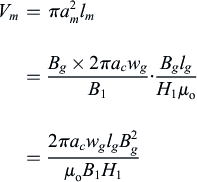Part XX: design factors affecting direct-radiator loudspeaker performance
A loudspeaker generally is designed to provide an efficient transfer of electric power into acoustic power and to effect this transfer uniformly over as wide a frequency range as possible. To accomplish this, the voice coil, diaphragm, and amplifier must be properly chosen. The choice of the elements and their effect on efficiency, directivity, and transient response are discussed here.
6.12. Magnet size
A cross-sectional sketch of a typical microspeaker is shown in Fig. 6.10. In this discussion, it is assumed that the coil fills the gap in the magnetic path without any air spaces and that it has the same permeability as free space. For the sake of argument, the wire cross section might be rectangular so that any gap width or length could accommodate an integer number of turns or layers, respectively. It is also assumed that the reluctances of the pole pieces are negligible in comparison with that of the gap, so these are ignored. The radii of the diaphragm, magnet, and coil are a, a
m
, and a
c
, respectively.
Suppose the solid curve in Fig. 6.11 to represent the demagnetizing portion of the hysteresis loop for a magnetizing force H
sat obtained with the coil gaps in Fig. 6.10 closed, where B
R
is the remanent flux density. To neutralize the residual magnetism, it is necessary to apply, by means of a suitable field winding, a demagnetizing magnetomotive force ℑ in ampere-turns. If H
C
is the coercive force and l
m
the length of the magnet, then ℑ
=
H
C
l
m
. Therefore, ℑ may be termed the inherent magnetomotive force for maintaining the remanent flux density B
R
.
With the coil gaps in Fig. 6.10 closed, let us reduce the magnetic field strength from H
sat to zero and then increase it to H
1 in the reverse direction, so that the flux density is reduced to B
1. The net magnetomotive force available to produce this flux density in the magnet is H
C
l
m
−
H
1
l
m
or in other words, the difference between the inherent MMF and applied MMF.
Next, let us gradually pull the pole pieces apart and at the same time reduce the demagnetizing current in the field coil so as to keep the flux density constant at B
1. Suppose the procedure to be continued until the current has been reduced to zero and suppose l
g
in Fig. 6.10 to be the corresponding gap length. Because this gap has been introduced without any change of flux density in the magnet, it follows that the magnetomotive force now available to send the flux ϕ across the gap is therefore H
1
l
m
, namely that neutralized by the negative magnetomotive force of the field coil before the gap was introduced. The flux ϕ across the gap is given by
where B
1 is the flux density in the magnet and B
g
is the flux density in the gap. In addition, the magnetomotive force required to send flux across the gap is given by
where μ
0
=
4π
×
10
−7
H/m is the permeability of free space, but it was shown that the magnetomotive force required to send flux across the gap is given by H
1
l
m
. Therefore,
 (6.76)
(6.76)
From Eq. (6.76), it is evident that for a given flux density in the given dimensions of the gap, the volume of the magnet is a minimum when the product B
1
H
1 is a maximum. The variation of this product with H in the magnet core is shown in Fig. 6.11 as a dashed curve from which it follows that the volume of the magnet is a minimum when it is operated at magnetomotive force H
max. The value of the product (BH)max, also known as the maximum energy product, for a magnetic material is the best criterion of its suitability for use as a permanent magnet and the volume is then given by
 (6.77)
(6.77)
Notice that
is the volume occupied by the gap. In addition, let us assume that the field in the pole pieces is in saturation so that B
g
=
B
sat. This prevents the field from varying significantly with the driving current in the coil and thus improves linearity. Hence, the magnet volume can be written as
If the demagnetization curve were perfectly linear, the values of H
max and B
max would be exactly half of the values of the coercivity and remanence, respectively, which are more commonly found in manufacturer's data than H
max and B
max. However, because of nonlinearity, a factor of 2/3 should give a reasonably good estimate for many materials, although neodymium iron boron (NdFeB) magnets [8] are remarkably close to ideal, as can be seen in Fig. 6.12. The upper curves are the intrinsic B versus H values which show the flux density excluding the flux due to the external applied field, and the
lower curves are the actual “normal” B versus H values including the total net flux. It should be noted that the intrinsic coercivity is slightly greater than the actual coercivity. Commercial NdFeB magnets are denoted by a grade which specifies the maximum energy product in mega-gauss-oersteds and the minimum intrinsic coercivity in kilo-oersteds. For example, a Grade N4811 NdFeB magnet has a maximum energy product BH
max of 48 MGOe and a minimum intrinsic coercivity H
ci
of 11 kOe. For our calculations, it is more convenient to use MKS units, in which case the conversions can be made using

Hence, a Grade N4811 NdFeB magnet has a maximum energy product BH
max of 382
kTA/m and a minimum intrinsic coercivity H
ci
of 875
kA/m.
..................Content has been hidden....................
You can't read the all page of ebook, please click here login for view all page.


